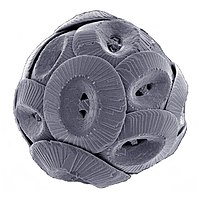
Photo from wikipedia
The silica frustules of diatom are regarded as an important physical defense against predation. While the biogenic silica content of diatoms is a major factor controlling the ingestion rate of… Click to show full abstract
The silica frustules of diatom are regarded as an important physical defense against predation. While the biogenic silica content of diatoms is a major factor controlling the ingestion rate of copepods, how it affects the three‐dimensional structure and the mechanical properties of the frustules, and consequently copepod grazing, has not been studied. In this study, the diatoms Thalassiosira weissflogii and Amphora coffeaeformis were grown under different light intensities to manipulate their cellular biogenic silica contents. This manipulation generated diatom cells with distinct nano‐structures and mechanical strengths. The diatoms were then fed to the copepod Paracalanus pravus to test the effect of biogenic silica contents on copepod feeding. We demonstrated that the copepods preferred the low‐silica cells of T. weissflogii, but showed a preference for the high‐silica cells of A. coffeaeformis. Atomic force microscopy and X‐ray photoelectron spectroscopy analyses revealed that the chemical composition and mechanical properties of diatom frustules varied with silica contents. High silica containing T. weissflogii had higher frustule elasticity and hardness. In contrast, A. coffeaeformis containing more biogenic silica had lower frustule elasticity but silica level had little effect on the hardness of the frustule. Our results indicate that the nano‐structure and chemical properties of the frustules determine the mechanical strength of the diatom frustules. This nanoscale study improves our understanding of the relationship between diatom biogenic silica content and copepod grazing in marine planktonic food webs.
Journal Title: Limnology and Oceanography
Year Published: 2021
Link to full text (if available)
Share on Social Media: Sign Up to like & get
recommendations!